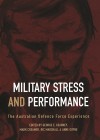Military Stress and Performance: the Australian Defence Force Experience
Written by: George E. Kearney, Mark Creamer, Ric Marshall and Anne Goyne (eds),
Melbourne University Publishing, Melbourne, 2003,
ISBN: 9780522850543, 294pp.
Reviewed by: Lieutenant Colonel David Schmidtchen, Directorate of Retention Policy, Defence Personnel Executive, Canberra
Of the 52 000 Australian Defence Force (ADF) personnel who served in Vietnam between 1962 and 1972, approximately 3000 were either killed or wounded in action. In 2002, the Department of Veterans’ Affairs recognised one in five of those that had seen service in Vietnam as suffering from Post-traumatic Stress Disorder. What does this tell us? First, that psychological injury is the most prevalent form of injury suffered in armed conflict. Second, that the debilitating effect of operational stress persists beyond the life of the incident or operation. Third, that postwar psychological injury is likely to be the greatest personnel cost borne by the ADF and Australian society. Since the Vietnam War, a more inquisitive and informed public has watched as the social and emotional costs borne by ADF personnel and their families have been revealed.
Military Stress and Performance brings the current state of operational stress research and practice to our attention. It provides a comprehensive review of the ADF experience and practice. A range of professionals—including psychologists, psychiatrists, medical doctors, social workers and chaplains—are struggling to understand the source, scale and dimension of the problem of stress on operations and its consequences. In Australia, professionals approaching the problem have deliberately adopted a multi-disciplinary approach that supports a healthy balance between research and practice. Military Stress and Performance reflects this tradition by drawing on a range of professional disciplines to provide an account of the ADF’s experience.
The book covers treatment methods, debriefing practices and first-hand accounts and observations. It is structured around four themes: ‘The Stress Phenomenon’; ‘Enabling Resilience’; ‘Health and Welfare after Deployment’; and ‘Caring for Casualties’. I was particularly drawn to Commodore Lee Cordner’s personal account of the stresses encountered by a commander at sea. Commodore Cordner moves from his experiences in preparing the HMAS Sydney to participate in the 1990–91 Gulf War and the Maritime Interception Force in the North Red Sea through to being ‘bemused by all the fuss’ on their return home. The value of commanders documenting their experiences of stress in command cannot be emphasised enough.
The contribution of four experienced Australian Army Psychology Corps (AAPSYCH) psychologists on the advances made in delivering psychological support during the 1990s is revealing. Their reflections bring together the collective experiences of the AAPSYCH Corps and the Defence Force Psychology Organisation in order to demonstrate how the theory and practice of psychology in operations has evolved. They also provide a clear statement on where practice can be improved. On finishing the book, it became clear to me why the methodology of the ADF’s success in dealing with operational stress is in demand from military forces around the world.
Professor Kearney does a commendable job of bringing together the main conclusions of the book. He does so by showing that the problem of operational stress has a long and difficult history that parallels society’s struggle to acknowledge, accept and address the problem. In Professor Kearney’s words, ‘This book contains advice on the best treatment methods; suggestions for the optimal method of debriefing; and accounts of first-hand observations. Highlighted throughout is the conclusion that there is a need for better understanding and more carefully controlled research.’ I agree, with the addition that it also shows how far the ADF has come in addressing the problem.
The editors acknowledge the difficulties of structuring the material to allow an easy flow from one section to the next. This book is best approached as a compendium of stand-alone articles that together contribute to a better understanding of a diverse topic. It can be distinguished from others addressing similar topics by the experience of the authors and the currency of the information. It combines the insights of some of Australia’s foremost researchers and practitioners in the field with the experiences of currently serving officers. The book left me with the sense of a work in progress in that we have come a long way, but considerable distance remains before we can claim to have solved the problem. I recommend this book to scientists and practitioners working in the area of operational stress, as well as to commanders, who will, after reading the book, benefit from a better understanding of how stress on operations affects people, the process of treatment and the factors that influence recovery.


